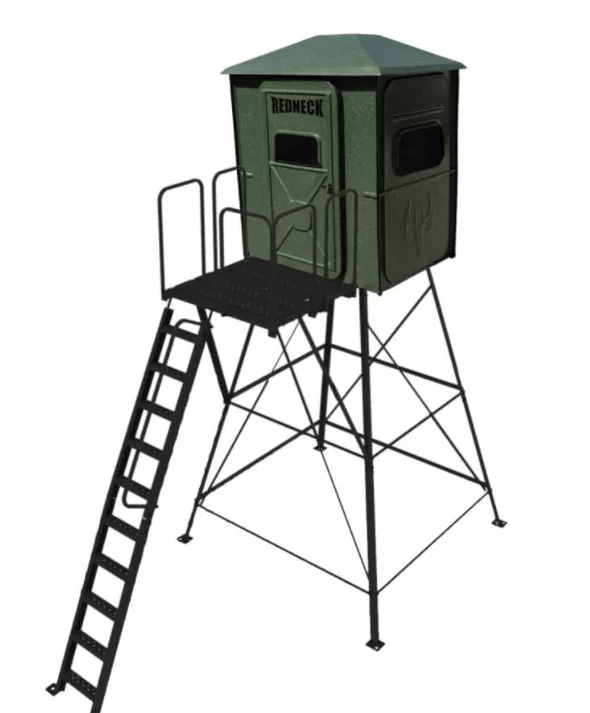Hunting Strategies and Late Season Box Blind Locations
Deer hunting is as much a mental game as it is anything else, isn’t it? As the holidays get closer and the mercury outside really drops, it’s tough to maintain that sense of optimism you had in the early season. But if you’re still waiting to notch a tag this year, trust us that it’s not too late. With some good hunting strategies and the right late season box blind locations, you can still be successful.
Post-Rut Bucks and Late Season Conditions
While hunting mature bucks during the pre-rut or even peak rut time periods is still no easy feat, it can seem a whole lot easier than the late season. Post-rut bucks are a different kind of animal. Pressured, worn out, and wary, any mature bucks left standing have seen a thing or two and require some different tactics to hunt effectively.
Depending on where you hunt, the term “late season” can mean very different things. To those in the Midwest or Northeast, it could mean lots of snow and subzero temperatures, dropping your hunts down to couple-hour increments. And to those in the south, it might mean damp and unseasonably chilly weather. But either way, it’s usually a big shift for the local deer herd and hunters alike. That can make deer hunting not as fun as it was in the prime fall conditions.
Benefits of Box Blinds
The combination of wary bucks and cold or miserable hunting conditions makes hunting out of box blinds an easy choice. And Redneck Blinds is an even easier choice when it comes to deciding which brand. Their blinds are constructed with durable, rugged materials and are built to last. They’re also very comfortable to sit in for those all-day hunts. Box blinds have several advantages over hunting in a tree stand.
From $1,799.99 to a Taj Mahal setup at $2,899.99 these blinds aren’t cheap. However, Redneck blind or tower setup is going to be a great long-term investment. From a stable go-to hunting location for first time hunters or family hunts, to cold late season sits, a Redneck blind will always provide great hunting opportunities. If you’re looking for a cheaper solution Rhino ground blinds is an easier price to digest for a solid blind setup for deer hunting, even in the late season. Starting at $149.99, A Rhino Blind it is a setup that can pitch fast over a food plot or bait site that just had a buck show up in the late season.

- Box blinds are fully protected from the outside elements, which keeps you warmer and drier than hunting in an exposed tree stand. This can extend your hunting time significantly, allowing you to hunt all day versus limiting it to a few hours before your willpower gives out. The Trophy Tower Platinum box blind is a great option to stay warm, dry, and comfortable for long days afield.
- Hunting from a box blind means your scent, sound, and sight are concealed better. This allows you to move around a little more freely and even film your own hunt easier. But by staying hidden, you have less chance of spooking a wise and wary buck.
- After being in place for a season, deer tend to ignore hunting blinds. Again, once you’re inside them, you are very hard to detect as a hunter. So provided you can get to and exit your late season box blind locations discretely, you have an easier time being within shooting range of a shooter without spooking it.

Late Season Box Blind Locations
Now this is where all the hunting magic comes together for late season deer hunting. If you can prepare a box blind (or a few blinds) in the right places well ahead of the season, you can be set up for hunting success when the time arrives. These late season box blind locations are where you need to put your focus.
Food Sources
This time of the year, whitetails are focused on their stomachs and anything that can fill them, which is why food sources are such good late season box blind locations. If you can hunt the edge of some preferred late season food sources – especially when it’s adjacent to great bedding/security cover – you have a dynamite hunting blind location. This isn’t always easy to anticipate, unless you plant food plots and protect them specifically for the late season.
- Imagine fencing off a few acres of standing corn, beans, or brassicas until all the fields around you are picked clean, and then letting those fences down – get ready to pick your buck, cause the deer will be there!
- You can also keep a box blind on a general ag field. Some years, the conditions might not be right for harvesting until later, so this late season hunting location should afford a few hunts. And even after it’s picked, the waste grain will still draw deer out.
- In the south especially, green fields (e.g., alfalfa, clover, etc.) will attract deer in the late season. A blind on the downwind side of a green field is always a good spot for an ambush.
The thing to keep in mind with this setup is that you need a solid plan to access your blind location. With a field full of feeding deer, it’s not easy to simply climb down without spooking at least a few. The closer you are to the action, the more you need to brush your tower in or arrange it against some dense undergrowth. For example, try raising a tower immediately behind some a large grove of cedars, which will block your sight and sound as you climb in and out.

Bedding and Transitional Areas
Because deer want to eat as much food and burn as few calories as possible, bedding areas are also very good late season box blind locations. Well, to be clear, immediately outside of bedding areas. If your property has a few dense areas where deer are known to bed every season when the weather gets rough, they might be prime spots to hunt. These areas could include spruce or cedar groves, dense CRP grasses, or cattail sloughs – you want to see lots of thermal cover.
Try raising a box blind far enough away and on the typical downwind side of this late season bedding cover so that you can’t quite monitor it (and deer can’t quite monitor you). You should also stay in between the cover and food sources to catch deer in transition between them. The danger in this setup is that your access needs to be airtight – no walking upwind of travel corridors or bedding. Maintain stealthy trails to avoid detection on your way in and out of the blind. If you can do that, you have a good chance of seeing some daylight glimpses of deer on their way to feed or sleep.
There’s still time to make things happen. But even if it has to wait until next year, keep these late season box blind locations in mind.


